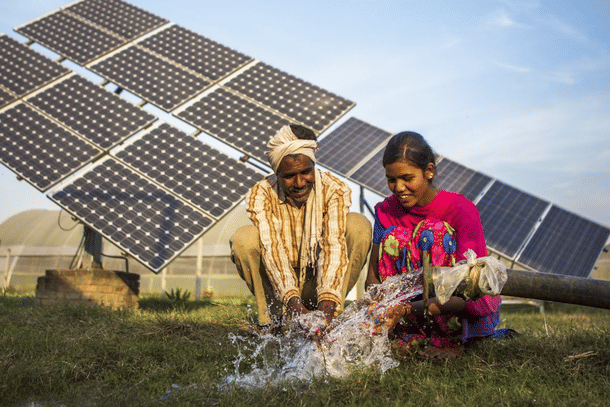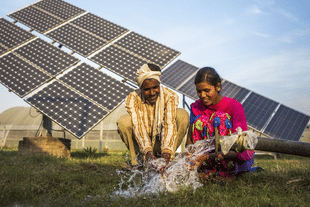Science
Diesel Out, Sun In: How Modi Government Aims To Make Agriculture Sector Diesel-Free
Amit Mishra
Mar 09, 2022, 02:06 PM | Updated 02:06 PM IST
Save & read from anywhere!
Bookmark stories for easy access on any device or the Swarajya app.


India has set an ambitious target to make the agriculture sector diesel free by 2024 by replacing diesel with Renewable Energy (RE).
This was stated by the Union Minister for Power R K Singh at a virtual meeting in February 2022 with state officials for collaboration between the Central and the state governments for achieving energy transition goals.
Uses Of Diesel
Energy use in agriculture at the farm level can be categorised as either direct or indirect. Direct energy use in agriculture is in the form of diesel and electricity to operate mobile and stationary equipment/machinery to prepare fields, plant and harvest crops, and transport inputs and outputs to and from markets. Indirect energy is consumed off the farm for the manufacture of inputs, such as fertilizers and pesticides.
In India, there are two types of diesel fuels: (1) high-speed diesel (HSD), used in automotive applications, and (2) light diesel oil (LDO), used in stationary applications. LDO is steadily being replaced by HSD, which is primarily a transport fuel.
Diesel Consumption
An All India Study conducted by M/s Nielsen (India) Pvt Ltd for Petroleum Planning and Analysis Cell (PPAC) of Ministry of Petroleum and Natural Gas has thrown up interesting data about use of diesel. The agriculture sector is a major consumer of diesel accounting for about 13 per cent of the total consumption.
Within agriculture, the consumption is as follows: tractors (7.4 per cent), pump-sets (2.9 per cent) and agriculture implements (2.7 per cent). Agri-implements largely stand for tractor related agri-equipment such as harvesters, threshers, etc.
Tractors have a higher consumption presumably because they are also used for non-agricultural purposes like transportation of construction material such as bricks, stones, mined sand, etc. and for transporting people in rural areas.
The Case Of Agriculture Pumps
Pump-sets in India are used in domestic, agriculture, construction and industrial sectors. Agriculture sector leads the usage of pumps in India with prominent uses like irrigation.
At present, over 30 million agricultural pumps are installed in India, out of which nearly 8 million pumps are diesel-based. Also, over 20 million grid-connected agriculture water pumps are installed in the country with an annual addition of 0.25 to 0.5 million pump sets.
The number of farmers using diesel-powered pumps is high in villages having remote or minimal access to electricity. Added to this, poor farmers are ignorant of the fact that using efficient and technologically advanced pumps will be beneficial to them by bringing down the fuel usage.
However, the high number of diesel-based pumps in the country is largely due to the inability of the Distribution Companies (DISCOMs) to energize these pumps through grid connection as seen from the long waiting lists with such DISCOMs.
The Reason For The Transition
Farmers have been demanding replacement of diesel pumps by electric pumps as the former one is costly to run. By replacing diesel pumps with solar pumps or connecting them to the grid, the farmers will get cheaper and more reliable power for irrigation resulting in savings in diesel cost.
Nearly 80 lakh pumps out of approximately 3 crore agricultural pumps installed in India are diesel pumps. The total diesel consumption of these pumps in a year works out to 5.52 billion litre per annum along with equivalent CO2 emission of 15.4 million tonnes.
Thus, it is imperative to switch to a diesel-free regime which would reduce import bills, and help achieve India’ ambitious climate goals. Moreover, farmers whose diesel pumps are replaced will be able to work on their farms in a pollution free environment.
PM-KUSUM
In February 2020, the Ministry of New and Renewable Energy (MNRE) launched a scheme namely, PM-KUSUM to provide financial incentives to farmers to use solar instead of diesel-fired irrigation pumps.
Pradhan Mantri Kisan Urja Suraksha evam Utthaan Mahabhiyan (PM-KUSUM) is one of largest clean energy initiatives of the world with three components, each having a dedicated focus area. The second component, namely Component-B: Installation of Standalone Solar Powered Agriculture Pumps is aimed at de-dieselisation of the farm sector.
Under this component, individual farmers are supported to install standalone solar agriculture pumps of capacity up to 7.5 HP for replacement of existing diesel Agriculture pumps / irrigation systems in off-grid areas, where grid supply is not available. Installation of new pumps is also permitted under this scheme except in dark zone areas.
Groups of farmers, such as Water User Associations and community/cluster based irrigation systems are also covered under this component. However, priority is given to small and marginal farmers. In order to minimise the water usage for irrigation purposes, preference is given to the farmers using micro irrigation systems.
Central Financial Assistance (CFA), upto 30 per cent of the benchmark cost (fixed by MNRE every year) of the standalone solar pump, is provided. The State Government gives a subsidy of 30 per cent; and the remaining 40 per cent is provided by the farmer. Bank finance up to 30 per cent out of 40 per cent share can be availed by the farmer, so that farmer has to initially pay only 10 per cent of the total cost of the pump.
However, in Sikkim, Himachal Pradesh, Uttarakhand, J&K, Ladakh, Lakshadweep, A&N Islands, and the north-eastern states, higher CFA upto 50 per cent of the benchmark cost of the standalone solar pump is provided.
With pumps being generally used for a limited period (150 days in a year), the installed solar capacity can be utilised for remaining days by using Universal Solar Pump Controller (USPC). A USPC enables the farmer to use solar power for other activities like operating his chaff cutter, floor mill, cold storage, drier, battery charger, etc. Installation of USPC is also permitted under this Component.
Benefits Envisaged
PM-KUSUM serves the objective of enhancing farmer’s income by replacing high cost diesel with less expensive solar energy. The replacement of existing diesel pumps with solar pumps reduces the irrigation costs of around Rs.50,000 per year (for 5HP pump).
When implemented fully, PM-KUSUM will lead to an annual reduction in diesel consumption of 1.38 billion litres per annum, thus reducing the import bill on account of petroleum products. It will also lead to reducing carbon emissions by as much as 32 million tonnes of CO2 per annum and thus aid in curbing climate change.
The scheme has a mandatory requirement for deploying domestically produced solar cells and modules under Component-B. This is expected to create demand of 20.8 GW for domestically produced solar cells and modules and thus give a fillip to domestic solar manufacturing. Moreover, enhanced domestic solar manufacturing will lead to a further reduction in the outgo on account of imports.
Amit Mishra is Staff Writer at Swarajya.




